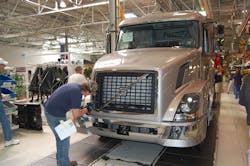Class 8 production levels are now running way ahead of market demand, according to new analysis by FTR Associates, thus OEMs need to start throttling their factories back or run the risk of creating too much inventory.
“We’re now projecting Class 8 demand to be flat through the rest of this year and into 2013,” explained Jonathan Starks, FTR’s director if transportation analysis, in a webinar held by the firm this week to provide an updated outlook for the North American commercial vehicle market.
“The [trucking industry] demand fundamentals suggest a sluggish second half of 2012 in terms of truck sales,” he said. “Class 8 order rates have been trending down since the start of the year, which is why we’re sharply reducing our forecast.”
Right now, Starks noted that there’s a 13% variance the number of Class 8 units OEMs plan to build in the third quarter this year versus what FTR predicts will actually be purchased – meaning OEM Class 8 production levels are 10,000 units higher than they should be, he warned.
That “variance” will only grow larger by year’s end, as FTR now projects market demand will only sustain annual Class 8 production volume of 263,000 units in 2012, dropping to 236,000 units in 2013.
“If OEMs keep building at the same pace, they’ll add 9,000 or so Class 8 units to inventory in the third quarter and 17,000 units to inventory in the fourth quarter,” Starks pointed out. “That means by 2013 they’d have to cut production levels by 30% to account for larger inventory.”
The major reason FTR pulled back its Class 8 forecast is that U.S. economy isn’t expected to perform nearly as well as once predicted.
Bill Witte, principle of Witte Economics and FTR’s economist, explained that the U.S. economy continues to follow a “sluggish” recovery pattern, with gross domestic product (GDP) growth rates only reaching 1.9% in the first quarter this year.
“Consumption accounted for all of that GDP growth, too, which is worrisome as consumer sentiment has now deteriorated,” he said.
Business investment is also in decline, with a 3% to 4% rate projected for the next year and a half as opposed to the 11% and 8% investment levels attained in 2010 and 2011, respectively.
On top of that, Witte noted that over the last three months (March, April, May) job creation has only netted out to 96,000; not quite half the amount of jobs created in the three months prior to that period (December, January, February).
Thus, FTR’s economic outlook for the U.S. is “a little more pessimistic, with more downside risk” for 2012, Witte said, with annual GDP growth predicted to be between 2.3% and 2.4%, versus previous expectations of 2.5%.
That projection for continued “slow growth” dovetails with other economic analysis – including the State of Logistics report released by the Council of Supply Chain Management Professionals this week.
“The faster paced recovery we have been watching for has failed to materialize and most economists feel that we are in this for the long haul,” noted Rosalyn Wilson, senior business analyst with Delcan Inc. and the report’s primary author.
“The [U.S.] economy continues to follow its slow, bumpy growth path and freight volumes are subject to the ups and down,” she said in a presentation this week, pointing out that U.S. GDP growth rate slowed to 1.7% in 2011, well below the 2.8% attained in 2010.
“The manufacturing sector of the economy has been in expansion mode for over 27 consecutive months, but just barely as measured by Institute of Supply Management,” Wilson added. “Manufacturing and business spending have carried the economy throughout the recession and recovery, but they were not as strong in 2011. The longer the recovery takes without solid sustainable economic growth, the more reticent businesses become about hiring and investment.”
However, while such data points convinced FTR to slash its Class 8 forecast, the firm said projections for medium-duty and trailer remain on track.
FTR’s Starks said the medium-duty truck market should remain in a “slow and low” pattern, supporting steady growth in annual production rates of 157,000 units this year and 185,000 units in 2013 – up from 129,000 units in 2011. However, he stressed that demand will also remain “constrained” by the outlook for sluggish U.S. economic growth, and thus annual production levels won’t crest the 200,000 unit mark until 2014.
By contrast, the trailer market is doing very well, though production is “peaking” in Starks words. FTR believes annual trailer production in North America should reach the 250,000 unit mark this year and stay around that level for 2013 and 2014. “They won’t return to the peak of 2006, but that’s a good level to be at,” Starks said.
What will sustain trailer production volume at this level is simple, he added: reform of hours of service (HOS) regulations expected to go into effect in July 2013, along with other regulatory overhauls as well.
Delcan’s Wilson said in the State of Logistics report this week that the new HOS rule will reduce the maximum number of hours a truck driver can work within a week from 82 to 70, causing a 3% to 8% percent loss of productivity for each driver.
That change alone is forcing fleets to increase their ratios of trailers to tractors, FTR’s Starks said. “That will help keep demand for trailers elevated,” he noted.
About the Author
Sean Kilcarr
Editor in Chief
Sean Kilcarr is a former longtime FleetOwner senior editor who wrote for the publication from 2000 to 2018. He served as editor-in-chief from 2017 to 2018.
